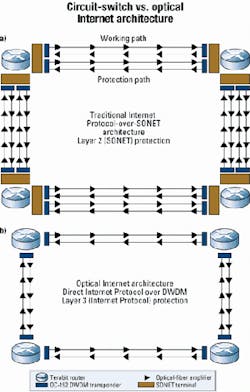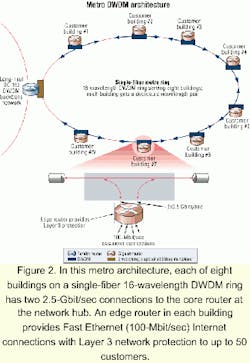Converge data and voice services? Not so fast.
Building a data network that's devoted to data services offers tremendous cost savings to service providers.
R. Brad Kummer, Cogent Communications
It can be done. It is done. But should it be done?
The technology certainly exists to deploy data and voice services over the same network architecture. Voice carriers do it. Hoping to offset the flattening revenues derived from their traditional offerings, voice carriers have constructed overlay networks to cash in on the opportunity to provide Internet Protocol (IP) services to business customers. But is a tool that was originally designed for one task, then jerry-rigged to perform another, the best for a job?
Networks built from the ground up strictly for data services offer tremendous cost savings to service providers, because there is less equipment to buy, deploy, manage, and maintain. Enterprise customers benefit because data-only service providers are able to offer radical pricing models. Service reliability is not sacrificed due to the technology advances available in today's terabit-class routers. And service providers do not have to be stingy with bandwidth because of the efficiencies gained through an Internet-optimized architecture.
A data-only network also allows Internet service providers (ISPs) to implement "cold-potato routing," keeping application service traffic on its own high-performance optical network until the last possible point in the transmission path, instead of dumping it into the "Internet cloud" at the first possible opportunity. Consequently, customers benefit from not only lower costs, but also a higher grade of service performance.
Optical-networking technology advances have enabled data-only service providers to realize significant reductions in network construction and operating costs. Legacy networks that carry IP traffic over an architecture originally designed for voice transmission require equipment and connections that are not needed in a data-only infrastructure.
Terabit-class routers, recently introduced on the market, can deliver the protection in data-only networks that traditionally has been provided by SONET terminals in voice-oriented infrastructures. The intermediate-system-to-intermediate-system (IS-IS) routing protocol delivers protection directly on the routers-at Layer 3-ensuring that application service traffic continues to flow even when a failure occurs.Figure 1. Most Internet backbone networks today are built using a network architecture originally designed for circuit-switched voice traffic (a). By taking advantage of new terabit-class routers with direct high-speed optical interfaces and deploying Internet Protocol directly over a DWDM optical transmission network, a much simpler and more cost-effective optical Internet architecture is possible (b). The routers are used for Layer 3 protection, eliminating the need for the traditional SONET protection path and even the SONET terminals.
In the traditional long-haul carrier network, SONET provides extremely fast signal restoration in the event of a line cut or equipment failure. It is a prerequisite of voice transmission and its "hard" failure mechanism. As shown in Figure 1a, SONET terminals are typically linked with two fiber pairs, which provide a working and separate dedicated protection path. In the event of signal loss, the SONET terminals switch to the protection path in less than 50 msec to prevent the dropping of the circuit. It's an affordable, effective Layer 2 protection method engineered for voice circuits' unique requirements of dedicated capacity and uninterrupted service.
But data is different-packet-switched and bursty with a "softer" failure mechanism. In the event of a fiber or equipment failure, the routers redirect the data traffic. The application layer detects and accounts for any lost packets by resending them. Performance degradation is negligible; application integrity is maintained. In the optical Internet, protection occurs at Layer 3 on the terabit-class routers. Via the IS-IS protocol, data is redirected to available routers or along active fiber within 1 sec, fast enough to be of little consequence for IP services.
In addition to providing network protection, the next-generation routers can also take over the multiplexing and framing functions traditionally performed by the SONET terminals. The routers interface directly with DWDM transponders in the optical network, accepting links of up to OC-192 (10 Gbits/sec). By eliminating the elements needed to support circuit-switched voice services, the optical Internet architecture (see Figure 1b) results in a network dramatically simpler than transporting data over a traditional voice-optimized network.For data-only service providers, the real benefit of the terabit-class routers is slashed capital network costs, which can then be passed on to customers in the form of more affordable service prices. Because of their expanded capabilities, the new routers not only take the place of the core switches in the data provider's network, but also eliminate the need for SONET terminals. OC-192 SONET terminals cost $300,000 to $500,000 each, so the savings on this equipment alone is significant. The optical Internet architecture also eliminates the need for protection fiber paths as well as the optronics necessary to light those fibers in a SONET-protected voice infrastructure.
These tremendous capital savings can be passed on to customers in the form of radically lower pricing. Building a network from scratch for Internet access and other data services can cut a service provider's capital costs by 50% to 70%. And since the network is much simpler with fewer components, reliability is increased and operation and maintenance costs are substantially lower.
Due to the cost of transport within a system originally designed for voice, it is not uncommon for ISPs to oversubscribe their metropolitan, shared-bandwidth access networks by 20 to 1. One customer's traffic competes with another for bandwidth. It is application cannibalism; there are winners and losers. But oversubscription is the only way, because these traditional service providers simply cannot afford to provide dedicated bandwidth to each customer.
The emergence of cost-effective DWDM solutions for the metropolitan market, deployed in an Internet-optimized architecture using Layer 3 protection makes dedicated bandwidth an affordable option for data-only service providers. That eliminates oversubscription and provides customers with a full-capacity, "clear-channel" connection to the Internet.
DWDM increases the capacity of a fiber-optic network by multiplexing 16, 32, or more wavelengths of light over a single cable. Data service providers can deploy DWDM networks in optical rings with individual wavelengths assigned to each building. A Layer 3 edge router in each building is used to provide Ethernet connections to individual customers within that building. One customer's link to the hub terabit router is never impeded on by another's traffic. Each customer's connection is dedicated, ensuring optimal performance even during the busiest periods of network activity. Physically, at the fiber level, it's a ring-network configuration. Logically, at the wavelength level, it's a star (or "hub and spoke") configuration.
Even without the presence of the SONET infrastructure, reliability is ensured. A metro DWDM ring architecture system can be configured to assign two completely independent diverse paths to the edge router in each building-one traveling clockwise around the ring, the other traveling counterclockwise. Traffic fails over to the opposite-direction path in the event of a cable cut or other signal loss. It is a Layer 3 protection scheme based on the open shortest path first routing protocol. With this approach, even in the worst-case scenario of a signal failure, a customer's link is oversubscribed by only 2 to 1-and then only temporarily until the failed wavelength or cable is restored.
An example of a metropolitan architecture is shown in Figure 2. A 16-wavelength, OC-48 (2.5-Gbit/sec) metro fiber ring links eight multitenant buildings using bidirectional transmission on a single strand of fiber. Two 2.5-Gbit/sec connections to each building run in opposite paths around the ring. With 5 Gbits/sec of total capacity, the service provider can provide a dedicated Fast Ethernet (100-Mbit/sec) Internet connection to as many as 50 customers in each building. The absence of oversubscription allows customers to benefit from a higher guaranteed quality of service (QoS).
High network transport costs have prompted traditional ISPs to design architectures that hand application traffic off to carrier wide area networks as early as possible, a transmission method called "hot-potato routing." Once into the Internet cloud, the traffic encounters the performance obstacles inherent in an infrastructure in which an IP network is overlayed on top of a circuit-switched system.
Cold-potato routing is the opposite approach. Service providers keep traffic within their own high-performance data-only networks for as much of the transmission path as possible, resulting in fewer network transitions and, in turn, reduced latency. Cold-potato routing can deliver a 70% reduction in average latency from the 200-msec delay that is standard among traditional ISPs. The difference in QoS frees a data service provider's enterprise customers to realize the Internet's greatest possibilities. For example, these companies can link customers and suppliers for real-time conferences, store massive data files offsite and have access as if the files were on the corporate LAN, or use streaming video and audio for distance-learning opportunities.
Building an optical network for data traffic entails capital costs of less than half the cost of overlaying an IP network on top of a traditional voice network. Not only is it less expensive, service providers can build higher-performance, more-scalable infrastructures. The benefit for customers is faster, more reliable, and radically less expensive services-in one case, $1,000 per month for 100 Mbits/sec of guaranteed bandwidth, as opposed to the average $1,500 per month for the 1.544 Mbits/sec delivered via a T1 line.
The impetus to entwine voice and data networking is understandable from the perspective of the traditional voice carriers. But the new generation of data service providers-and their customers-are learning that convergence isn't for everyone. For data-only service providers, using the right tool for the job means dramatically reduced costs, increased network performance, and a happier customer base.
R. Brad Kummer is vice president and chief technology officer with Cogent Communications (Washington, DC). He can reached at ([email protected]).


